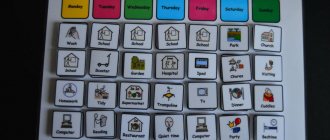Communication is an integral part in the life of every person.
By exchanging information, expressing our thoughts, opinions, advice and feelings, we can live normally in society, set goals and confidently approach their achievement.
In disputes, friendly conversations and simple exchanges of information, interlocutors do not always openly express their thoughts and feelings.
Verbal and non-verbal communication - these two components are inherent in the communication of each of us. By being able to recognize the signs of nonverbal communication during a conversation, it is much easier for a person to form the correct opinion about his environment.
The essence of verbal communication - what it is and why it is needed
Verbal communication refers to oral as well as written speech. It is with their help that we can express our opinions, thoughts, openly argue with a companion, give arguments, share impressions with friends, talk about what we saw, heard, read, etc.
When one speaks, the other listens very carefully and responds. This could be agreement, outrage, argument, or simply absorbing new interesting information. The lack of verbal communication makes every person lonely, withdrawn and isolated from the outside world. It is thanks to disputes, explanations and presentation of their thoughts that people come to a compromise and find a way out of difficult situations.
Correctly delivered speech is an important factor in verbal communication, which benefits everyone. How quickly a person can navigate a conversation, answer questions, establish new connections and express thoughts will directly determine his place in this world. When applying for a job, management pays special attention to these factors.
In addition to simple words and sentences, the emotional message plays a particularly important role. By intonation, tone, and speed of explanation, you can understand the mood of the interlocutor. Screaming, dissatisfaction, and criticism most often cause a response in the form of aggression and ignoring the interlocutor. When the boss (friend, parents) chooses the right words and speaks calmly, it is easier for the employee to process the information received, find the mistake made and correct it.
Two main types of communication
The process of exchanging information and influencing all participants in communication is divided into two large groups. All functions of communication must be carried out in these groups, otherwise it will not be productive.
Verbal communication involves the verbal transfer of information. In this process, someone speaks and someone listens.
Nonverbal communication occurs through the implementation of an optikokinetic system of signs. Gestures, facial expressions, pantomime are appropriate here, special attention is paid to tone and intonation, and eye contact occurs. This method of communication outwardly expresses the inner world of a person, his personal development.
Means of verbal communication
The main means of this type of communication is human speech. It is thanks to spoken (written) words that a person can convey his words, thoughts, and also learn new information. In addition to understanding and knowing words, you need to be able to construct them correctly into a sentence and convey them to your interlocutor.
The following means of verbal communication help with this:
- Intonation plays an important role in the communication process and helps to show your position regarding the current situation. For a more comfortable conversation, it should be smooth and calm. In this case, all information is easier to understand and perceive by the listener.
- Voice quality is another important aspect. Of course, everyone has their own timbre and voice. But his training and ability to possess him plays to his advantage. After all, quite often there are people with very loud or quiet voices by nature. This makes conversations uncomfortable because others have to listen or feel uncomfortable because of the noise. Insecure individuals most often speak almost in a whisper, quickly and swallowing the ending. Ambitious and purposeful – they pronounce phrases clearly, loudly and clearly.
- Rate of speech is another means that can tell a lot about a person’s feelings in a given situation. The type of temperament also plays a significant role. Melancholic and phlegmatic people, unlike sanguine and choleric people, are slow in conversation.
- Logical and phrasal stress allow each person to highlight the most important details in his story. Our perception of the information we hear depends on the correct emphasis in words.
What is nonverbal communication?
By not paying attention to signs of nonverbal communication, people can make big mistakes. Many people listen with their ears, despite the fact that the interlocutor’s “body language” screams the opposite.
Nonverbal language is expressed in several forms that differ from each other.
1. Kinesics includes pantomime, facial expressions and gestures. Quite often, in an emotional conversation, a person begins to wave his arms (gestures), make faces (facial expressions) or take a closed pose with his arms crossed over his chest (pantomimes). Any even inconspicuous movements during a conversation can become a sign of disdain, mistrust, arrogance, affection or respect.
By learning to notice little things and understand the mood of your interlocutor, you can avoid quarrels and unnecessary conflicts, and also wait for the right moment to achieve your goal and a calm mood. After all, quite often you can see from a person in what mood he returned from work (study). This may include a heavy, stooped gait, prolonged silence, reluctance to answer questions, or closed postures. If you approach a relative (friend) with reproaches and aggression over a trifle, it will be impossible to avoid a reciprocal outburst of emotions.
2. Takeshika is another form of non-verbal communication. Without knowing its basics, conflicts and misunderstandings often arise between people. Touching is the main component of this type. Handshakes, hugs, pats on the shoulder and much more include takeshika. Depending on how exactly these movements are carried out (distance, compression force, etc.) the mood or attitude of a person towards his interlocutor directly depends.
Quite often on public transport during rush hour people have to crowd together. In this case, many suffer discomfort and feel uncomfortable. Intense proximity due to crowding leads to the fact that people unintentionally invade each other's personal space (the range of which is from 115 to 45 cm). On a subconscious level, this is regarded as a danger and causes responses in the form of dissatisfaction and constraint.
3. The components of prosody are volume, intonation and pitch of the voice. They are more recognizable and understandable signs for most people. Almost everyone knows what a raised voice and harsh intonation mean.
4. Extralinguistics are additional reactions during a conversation. This includes laughter, sighs, surprising exclamations and pauses in speech.
Extralinguistics and prosody act as an addition to verbal communication. With their help, you can determine the mood and emotional state of your interlocutor.
Sign language
Gestures are usually called socially practiced movements that can convey a person’s emotional state. There are a very large number of gestures, and they are all classified according to the purpose of transmitting information by a person and his internal state. Gestures are:
- illustrators (complement the message);
- regulators (the person’s attitude is visible);
- emblems (common symbols);
- affectors (transmission of emotions);
- assessments;
- confidence;
- uncertainty;
- self-control;
- expectations;
- denial;
- location;
- dominance;
- insincerity;
- courtship.
By how a person behaves during a conversation, one can determine his internal state, how interested he is in the exchange of information, and whether there is sincerity.
Building relationships, taking into account the secrets of nonverbal communication
In the process of communication, both verbal and nonverbal types of communication are equally important for a person. Good orientation and understanding of “body language” will allow you to avoid deception, see your opponent’s true feelings or hide your own. Speakers are particularly knowledgeable and oriented to the principles of conversation and communication in two languages. Artists, philanthropists, politicians and other speakers use self-control in all interviews and speeches. This helps not to reveal true thoughts and feelings and avoid condemnation from the public.
Taking into account all the nuances of nonverbal communication, as well as correctly recognizing its essence, each person will be able to understand their interlocutors, establish profitable relationships and achieve their goals. The ability to speak correctly and win over listeners guarantees trust, desire to cooperate and help.
Establishing personal and business relationships or avoiding scams and deception - all this is possible if you correctly recognize the message that manifests itself on the subconscious level of the interlocutor. Sometimes facial expressions, posture and gestures say much more than words.
Basic secrets that will help you recognize a person’s true emotions in the process of communication:
1. Excessively intense hand gestures indicate emotional arousal. Too sudden movements are a sign that the narrator is trying his best to convey to the listener the information being conveyed. Most often, friends talk in this way about their victories and achievements, situations that have happened in their lives.
It is worth noting that a person’s nationality and temperament play a significant role in this factor. It is known that the Portuguese and Italians almost always use gestures during conversations. Finns are more reserved and reserved. Our country is at the center of this bar.
2. Many of us are accustomed to reading emotions in the face of our interlocutor. A malicious grin speaks of gloating. Raised eyebrows indicate surprise. A narrowed look of distrust. Looking at the facial expressions of your acquaintances, you can note a lot of useful information for yourself.
Eye contact is an important element of any dialogue. The level of their relationship depends on how easy it is for people to look each other in the eyes. When there is discomfort, deceit, lies and hypocrisy, a person always looks away or tries to avoid direct contact. A very long and intent gaze from an unfamiliar person or stranger is evidence of a negative and aggressive attitude on his part. During the communication process, each participant in the conversation should feel comfortable and at ease.
3. Gait is part of pantomime and can tell a lot about a person. Looking from the outside, you can see the internal state and mood of the person walking. A raised head and a long stride always indicate confidence and a positive attitude. Slouched shoulders, heavy movement of the legs, and a downcast gaze always indicate the opposite, namely, a bad mood, thoughtfulness and concern. When angry, the gait is most often abrupt and fast.
4. The interlocutor’s posture is another very important point that can tell a lot about the interlocutor’s mood for communication, his attitude towards the narrator and everything that is happening. Everyone knows that arms crossed on the chest indicate isolation, reluctance to communicate or share the point of view of your opponent.
Little things like this play a significant role in the process of building a career. After all, if during a discussion (creating a project, distributing responsibilities), the boss or employees nod and agree, while being in a closed position, one should doubt their sincerity and desire to support.
Giving someone something to hold can encourage them to open up. A turned body and a free (not crossed) position of legs and arms indicate openness, sincerity and a desire to communicate. To relieve the discomfort during a promise, which is felt upon first meeting, you can listen to the advice of psychologists and try to mirror his postures, facial expressions and gestures. This way, you can tune in to the wavelength of your interlocutor and establish contact.
mirror, that is, repeat the pose, gestures and facial expressions of the interlocutor. This way, you can tune in to the same wavelength and make communication easier.
5. A handshake can also tell a lot about the attitude of men towards each other. A squeeze that is too tight indicates a person’s power and aggressiveness. A barely noticeable squeezing of the fingers indicates uncertainty.
Gaining trust and winning over listeners, making them trust and form friendships - all this is possible if you curb your emotions and learn to use nonverbal communication correctly. Quite often, the basis of trust in missions from sectarian churches, managers, politicians, and speakers lies in their correct disposition towards themselves. Posture, intonation, presentation of information, gaze - all these little things are of particular importance in the process of speaking, business negotiations, searching for investors, etc.
It can take years to learn to completely take control of your feelings and prove what is said through nonverbal communication.
Why is knowledge of nonverbal communication so important in the modern world?
Quite often, people misperceive the feelings and intentions of their acquaintances. In addition to body language, there is also an internal state or habits. A closed posture does not always indicate a biased attitude towards the interlocutor. It happens that something has happened to a person or he is not in the mood to engage in fun discussions and share his thoughts. It all depends on emotions and inner mood.
That is why the ability to notice all the little things and compare them with each other helps to find friends, understand relatives (acquaintances), not rush to conclusions and form the right opinion.
Internal features also play a significant role. Most people have their own habits. Some tut, others curl their lips into a tube (gnaw them), raise their eyebrows, and so on. Such habits cannot be attributed to nonverbal communication and equated to personal relationships.
Starting to learn the secrets of nonverbal communication and compare subconscious signals with spoken phrases, you should pay attention to your behavior. By conducting self-analysis and observing how the body reacts to different phrases, people and events, each person will be able to more adequately understand others.
By being able to recognize (understand) body language, a person will be able to find true friends and like-minded people, achieve goals, gain the interest of listeners and see negative envious people and liars.
If you find an error, please select a piece of text and press Ctrl+Enter.
Human facial expressions
Human facial expressions are also a way of informing. When the face is immobile, 10-15% of all information is lost. If a person is deceiving or hiding something, then his eyes meet the eyes of the interlocutor less than a third of the time of the entire conversation. The left side of a person's face is more likely to show emotions. Accurate messages about a person's condition are conveyed through the eyes or the curvature of the lips. This occurs due to the behavior of the pupils - their contraction and dilation is beyond our control. When we experience the emotions of fear or sympathy, the pupils characteristically change.








